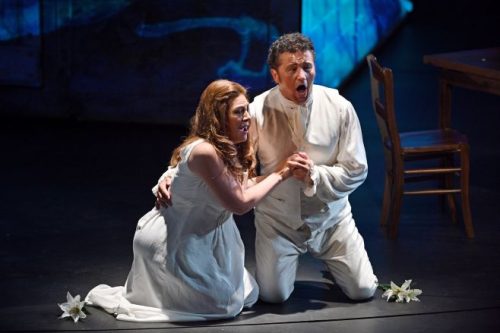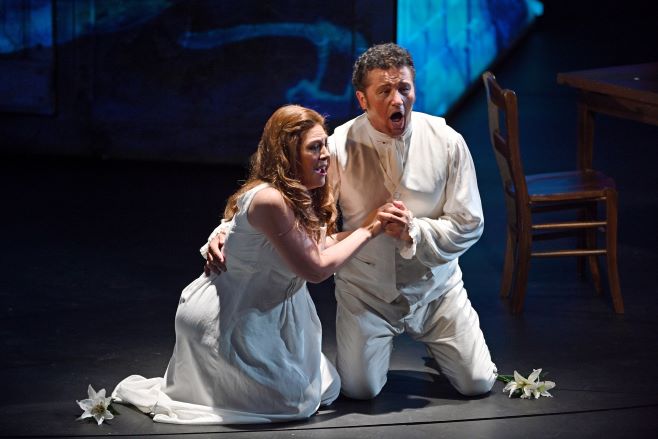 Spain Verdi, Luisa Miller: Soloists, Liceu Chorus and Orchestra / Domingo Hindoyan (conductor), Gran Teatre del Liceu, Barcelona, 23 & 24.7.2019. (JMI)
Spain Verdi, Luisa Miller: Soloists, Liceu Chorus and Orchestra / Domingo Hindoyan (conductor), Gran Teatre del Liceu, Barcelona, 23 & 24.7.2019. (JMI)

Production:
Director – Damiano Michieletto
Sets – Paolo Fantin
Costumes – Carla Teti
Lighting – Hans-Rudolf Kunz
Casts:
Luisa Miller – Sondra Radvanovsky/Eleonora Buratto
Rodolfo – Piotr Beczala/Arturo Chacón-Cruz
Miller – Michael Chioldi/Juan Jesús Rodríguez
Count Walter – Dmitry Belosselskiy/Carlo Colombara
Wurm – Marco Mimica/Marco Spotti
Federica – J’Nai Bridges/Sonia Prina
Laura – Gemma Coma-Alabert
Villager – Albert Casals
The Liceu opera season has ended with these performances of Luisa Miller which featured two different casts. The first one, with Sondra Radvanovsky and Piotr Beczala in the leading roles, was exceptional. I might have added Leo Nucci but he, unfortunately, canceled.
Luisa Miller has been one of Verdi’s most unjustly neglected works, although lately it does seem to be performed more regularly in the main opera houses. It has often been written that there are two main Verdi periods: the initial one, the so-called galley-slave years, and the mature period. I am not a musicologist, but my many years of listening to Verdi operas have led me to distinguish not two but three: the initial one, the mature period and the age of genius. The beginnings of the latter two would be marked by Luisa Miller and Otello.
I greatly admire Luisa Miller: it advances the musical drama and is a revolution from the initial works of the galley years. The first act is a continuation of traditional Verdi, but from there on we are facing a real drama in music: an opera of enormous vocal difficulties, particularly for the soprano, whose evolution throughout the opera reminds me of Violeta in La traviata.
This Damiano Michieletto staging, which premiered at the Zurich Opera in 2010, emphasizes the parent-child relationship: the parents are very protective of the protagonists and responsible for the tragedy faced by them. Michieletto puts two children on stage who represent the protagonists, and who will only be able to join up at the end of the opera, when the poison has had its effect on them.
There is one basic set which rotates to show the homes of Luisa, Rodolfo and their parents. In the last two acts walls are erected that enclose the stage somewhat, though nothing much changes. The costumes are a mixture of styles, from the time of Schiller for the parents to the beginning of the twentieth century for the chorus.
The musical direction was in the hands of Domingo Hindoyan, who is often at the Berlin Staatsoper; I think this is the first time he has conducted an opera in Spain. He made a positive impression with an intense, dramatic reading that never covered the singers. He drew a fine performance – better than usual – from the orchestra.
Sondra Radvanovsky returned to Barcelona after her triumph in Andrea Chénier last season. Luisa Miller is not a frequent character in her repertoire, which is not surprising given that one can almost say two different sopranos are required for the demands of this character. Sondra Radvanovsky is in a splendid moment and gave a great performance, solving perfectly the passages of almost light soprano in Act I, including the coloratura, and the drama of the next two acts. It would be difficult to find a better interpreter for this difficult character.
The second Luisa Miller was Eleonora Buratto, and her evolution is a curious one. I had the opportunity to see her for the first time seven years ago when she was clearly a light soprano. Her repertoire has evolved into heavier roles, and today she is a lyric soprano who continues to display an attractive voice, singing with gusto and expressiveness. It was her debut in the part, and she made a positive impression. She had no problems in Act I and was intense in the next scenes but without forcing her voice. She does not reach the level of Sondra Radvanovsky, but she is a splendid interpreter.
Rodolfo in the first cast was played by Piotr Beczala who was outstanding, always singing with a beautiful voice and extraordinary taste. It is a privilege to hear this singer on stage, and this was acknowledged by the audience after the always awaited aria, ‘Quando le sere al placido’, where there were calls for an encore. It is true that his top notes are a little thinner but, if they weren’t, we would be facing a new Pavarotti (whom he surpasses as a singer).
In the second cast was tenor Arturo Chacón Cruz, whose performance was somewhat lacking in nuance because he invariably sings everything in forte.
Luisa’s father was sung by baritone Michael Chioldi. His voice has quality and homogeneity, although he requires more volume to respond to the demands of a Verdian baritone. He sang with good taste and his interpretation was positive.
In the second cast Juan Jesús Rodríguez was excellent as Miller, showing again that we are before one of the most important Verdian baritone voices today. He sang with expressiveness and gave appropriate accents to his phrasing. It was surprising to see him in the second cast rather than the first.
Bass Dmitry Belosselskiy as Count Walter, Rodolfo’s father, gave a good performance, although he was less convincing that three years ago when he sang the role at the Teatro Real. Carlo Colombara was fairly modest as Count Walter in the second cast. The evil Wurm was bass Marco Mimica in the first cast and Marco Spotti in the second, and both did well.
Duchess Federica was played by J’Nai Bridges. I had heard a lot about her, and the truth is that I was somewhat disappointed. In the second cast, Sonia Prina, whom we often see in Baroque operas and in transvestite characters, was good. In the secondary characters, Gemma Coma-Alabert as Laura and Albert Casals as the Villager were satisfying.
The audience gave a warm reception to the artists, with special applause for both Sondra Radvanovsky and Piotr Beczala.
José M. Irurzun
